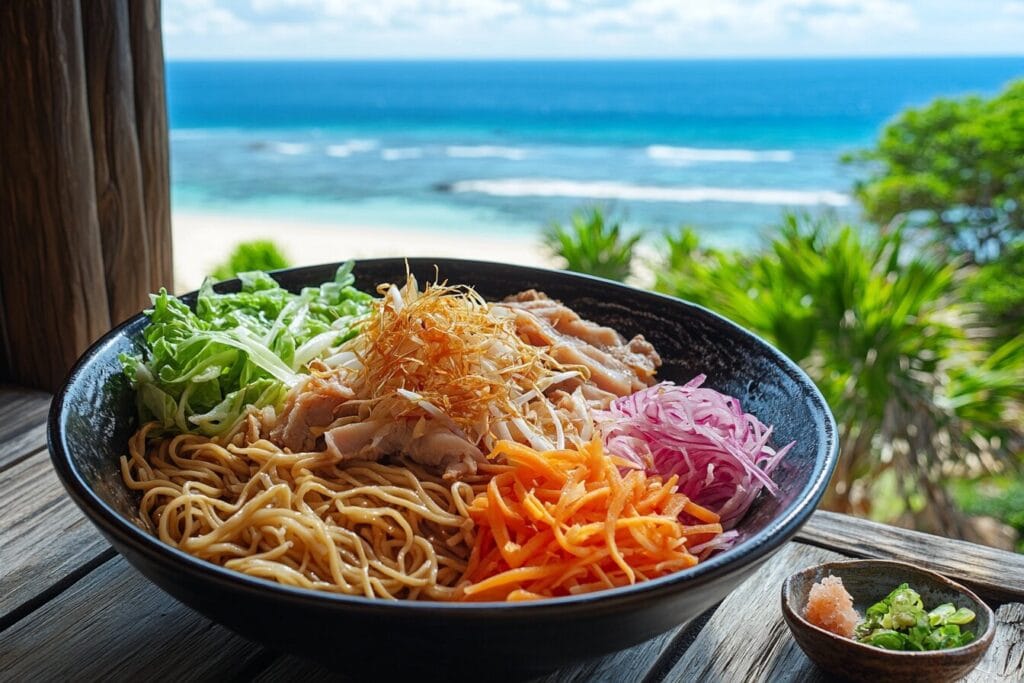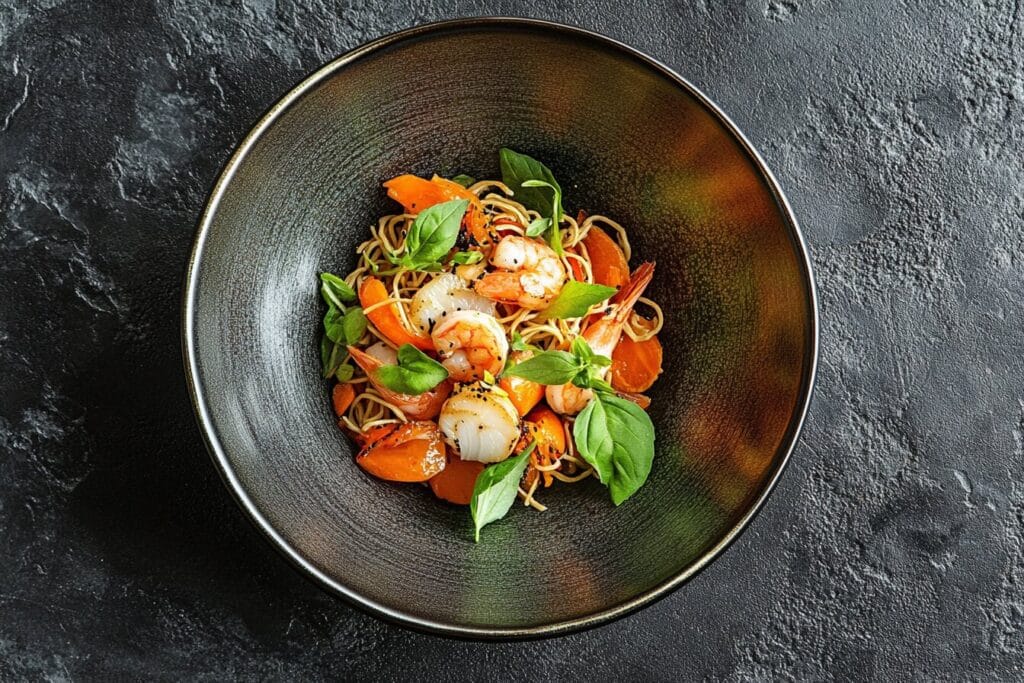Introduction
Yakisoba, a popular Japanese stir-fried noodle dish, has delighted food lovers across the globe. With its rich flavors, satisfying texture, and comforting warmth, this dish is more than just a meal—it’s a culinary masterpiece and cultural icon. But what makes yakisoba so irresistible? From its savory, umami-rich sauce to the harmony of fresh vegetables and tender noodles, every bite reflects a blend of tradition, creativity, and culinary expertise. In this article, we’ll dive into the elements that make this dish so special, from its ingredients and history to its preparation and worldwide appeal.

The History of Yakisoba
Yakisoba’s Humble Beginnings
Yakisoba originated in Japan during the early 20th century. Inspired by Chinese chow mein, this dish quickly adapted to Japanese tastes by incorporating locally sourced ingredients like Worcestershire-style sauce and regional vegetables.
A Festival Favorite
Yakisoba became a staple at Japanese matsuri (festivals), where it is often served in paper trays and enjoyed amidst lively celebrations. Its ease of preparation and ability to cater to large crowds solidified its place as a street-food favorite.
Global Expansion
As Japanese cuisine gained global recognition, yakisoba followed suit. It evolved to suit international palates, with regional twists showcasing the dish’s versatility while maintaining its traditional roots.
Key Ingredients of Yakisob
Noodles
The noodles in yakisoba are made from wheat flour and are similar to ramen noodles, though slightly firmer and less salty. These noodles provide the perfect base, absorbing the rich sauce while retaining their chewy texture.
Yakisoba Sauce
At the heart of yakisoba lies its sauce, a harmonious blend of Worcestershire sauce, soy sauce, oyster sauce, and sugar. This combination creates the signature tangy-sweet umami flavor that defines the dish.
Vegetables and Proteins
Classic yakisoba features shredded cabbage, onions, and carrots, complemented by proteins such as thinly sliced pork, chicken, or seafood. Vegetarian versions often substitute tofu or mushrooms for the protein.
Garnishes
Common garnishes include aonori (seaweed flakes), beni shoga (pickled ginger), and a sprinkling of katsuobushi (bonito flakes), which enhance the dish’s flavor and visual appeal.
The Perfect Flavor Profile
Understanding the Magic of Umami
Umami, often described as the “fifth taste,” is what makes yakisoba so satisfying. Derived from ingredients like soy sauce and oyster sauce, this savory flavor enhances the dish’s depth. Umami activates taste receptors, making every bite more delicious and leaving a lasting impression.
Balancing Sweetness and Tanginess
Yakisoba sauce’s sweetness comes from added sugar or mirin, which balances the tanginess of Worcestershire sauce. This duality creates a flavor harmony that appeals to a wide range of palates.
The Role of Texture in Flavor
Beyond taste, the contrasting textures of soft noodles, crunchy vegetables, and tender proteins contribute to the dish’s appeal. Every bite offers a satisfying interplay of chewiness and crispness.
Optional Heat and Spice
For those who enjoy a bit of spice, yakisoba can be elevated with chili oil or pepper flakes. This addition introduces heat that contrasts with the sweetness and tanginess, adding complexity to the dish.
Variations Around the World

Classic Japanese Yakisoba
In Japan, the traditional preparation focuses on pork, cabbage, and onions, garnished with bonito flakes and pickled ginger. This version is commonly served at festivals and food stalls.
Seafood
A coastal twist on the dish includes shrimp, squid, and scallops, providing a fresh and briny flavor. This variation is popular in regions near Japan’s coastlines and in gourmet Japanese restaurants.
Vegetarian
For plant-based eaters, yakisoba can be made with tofu, mushrooms, and a medley of colorful vegetables. The umami-rich sauce ensures this version remains as flavorful as the classic dish.
International Takes on Yakisoba
- Hawaiian Yakisoba: Features pineapple and teriyaki flavors for a tropical touch.
- Korean-Inspired Yakisoba: Adds gochujang (fermented chili paste) for a spicy kick.
- Westernized Yakisoba: Often includes chicken breast and broccoli, catering to global tastes.
How to Make Yakisoba at Home
Ingredients You’ll Need
Creating yakisoba at home is both simple and rewarding. Here’s what you’ll need:
- Noodles: Pre-cooked yakisoba noodles or fresh ramen noodles.
- Protein: Thinly sliced pork, chicken, tofu, or seafood (optional).
- Vegetables: Shredded cabbage, julienned carrots, bean sprouts, and sliced onions.
- Sauce: A blend of Worcestershire sauce, soy sauce, oyster sauce, ketchup, and sugar.
- Garnishes: Aonori, pickled ginger (beni shoga), and bonito flakes.
Step-by-Step Instructions
1 – Prepare the Ingredients
Wash and cut the vegetables into bite-sized pieces. Slice the protein thinly to ensure even cooking. If using pre-packaged noodles, loosen them by running them under warm water.
2 – Cook the Protein
Heat a large skillet or wok over medium-high heat. Add a tablespoon of oil and cook your protein of choice until it’s lightly browned and fully cooked. Remove from the pan and set aside.
3 – Stir-Fry the Vegetables
Add another tablespoon of oil to the same pan. Stir-fry the vegetables, starting with onions and carrots, as they take longer to cook. Add cabbage and bean sprouts toward the end to retain their crunch.
4 – Combine Noodles and Sauce
Add the noodles to the pan, followed by the yakisoba sauce. Stir everything together until the sauce evenly coats the noodles and vegetables. If the noodles stick, add a small amount of water or stock.
5 – Garnish and Serve
Return the protein to the pan and mix well. Serve the yakisoba on a plate, garnishing with aonori, pickled ginger, and bonito flakes for an authentic touch.
Pro Tips for the Perfect Meal
- Avoid Overcrowding the Pan: Cook in batches if needed to ensure even stir-frying.
- Customize the Sauce: Adjust the ratio of Worcestershire sauce and sugar to suit your taste.
- Experiment with Toppings: Try sesame seeds, fried eggs, or sliced green onions for extra flavor.
Health Benefits of Yakisoba
A Balanced Dish
Yakisoba contains a mix of carbohydrates, proteins, and vegetables, making it a relatively balanced meal. The addition of cabbage and carrots provides fiber and vitamins, while proteins like pork or tofu add essential nutrients.
Customizable for Dietary Needs
- Low-Sodium Diet: Reduce soy sauce and Worcestershire sauce in the recipe.
- Gluten-Free Option: Substitute regular noodles with gluten-free rice noodles and use tamari instead of soy sauce.
- Vegetarian Version: Skip the meat and add extra vegetables or plant-based proteins.
Portion Control and Moderation
While yakisoba is a flavorful and nutrient-rich dish, it can be high in sodium and calories due to the sauce. Moderation and mindful portion sizes can help maintain its health benefits without overindulgence.
Yakisoba vs. Other Noodle Dishes
Yakisoba’s uniqueness lies in its sauce, preparation style, and cultural context. Comparing it to other popular noodle dishes highlights its distinct character and flavor.
Chow Mein vs. Yakisoba
- Flavor Profile: Both dishes feature stir-fried noodles, but their flavor bases differ. Chow mein relies on soy sauce, creating a savory simplicity, while yakisoba’s Worcestershire-based sauce adds a tangy, umami-rich depth.
- Noodles: Chow mein uses thinner noodles, often fried to create a crispy texture. Yakisoba’s noodles are thicker, softer, and chewier.
- Ingredients: Bok choy and bamboo shoots are common in chow mein, contrasting with the cabbage, carrots, and Japanese seasonings central to yakisoba.
Pad Thai vs. Yakisoba
- Flavor Profile: Pad Thai leans heavily on tamarind paste for its sweet-and-sour notes, while yakisoba’s umami-packed sauce brings a savory and slightly tangy taste.
- Noodles: Pad Thai is made with flat rice noodles, which differ significantly from yakisoba’s wheat-based noodles.
- Garnishes: Pad Thai is finished with crushed peanuts and lime wedges for brightness, whereas yakisoba often features pickled ginger and bonito flakes for bold, savory accents.
Yakisoba vs. Lo Mein
- Cooking Style: Yakisoba involves stir-frying noodles with sauce and toppings, creating a cohesive dish. Lo mein, on the other hand, tosses boiled noodles in sauce after cooking.
- Sauce: While lo mein uses soy sauce and oyster sauce, yakisoba’s Worcestershire-inspired sauce provides a tangier, more complex flavor.
- Cultural Context: Yakisoba has deep roots in Japanese festivals and street food traditions. Lo mein is a hallmark of Chinese-American cuisine, often served in a variety of restaurants.
Popular Occasions for Yakisoba
Yakisoba’s versatility makes it a favorite for many occasions, from bustling festivals to cozy family dinners.
Festivals and Street Fairs
In Japan, yakisoba is synonymous with street fairs and festivals (matsuri). Vendors prepare it on massive grills, creating a mouthwatering aroma that draws crowds. Served in paper trays, it’s perfect for eating on the go while enjoying the festive atmosphere.
Family Gatherings
Yakisoba is a quick and easy dish for family meals. Its adaptable recipe allows for diverse ingredients, making it ideal for casual weeknight dinners or weekend lunches. The ability to tailor the ingredients to individual preferences adds to its family-friendly appeal.
Bento Box Favorite
Cold yakisoba is a common addition to bento boxes in Japan. Its bold flavors hold up well even after chilling, making it a convenient and satisfying option for packed lunches.
Comfort Food for Any Time
Whether eaten as a hearty main course or a quick late-night snack, yakisoba is a go-to comfort food. Its warm, savory flavors and filling nature make it a dish people turn to whenever they crave something satisfying and flavorful.
FAQs:
Yakisoba intrigues food lovers with its bold flavors and rich cultural heritage. Though it may appear simple, this beloved Japanese stir-fried noodle dish is layered with complexity and charm, sparking curiosity around the globe. From its unique ingredients to comparisons with other noodle dishes, there’s much to discover about yakisoba. In this section, we’ll answer frequently asked questions, uncover what makes yakisoba truly special, explore ways to customize it, and share tips for enjoying this iconic dish to its fullest.
What Makes Yakisoba Unique Compared to Other Noodle Dishes?
Yakisoba stands out because of its tangy, umami-packed sauce and its connection to Japanese street food culture. Unlike other noodle dishes, it uses Worcestershire-style sauce, which gives it a distinct savory-sweet flavor that’s hard to replicate.
Can Yakisoba Be Made Gluten-Free?
You can make yakisoba gluten-free by using gluten-free rice noodles and replacing soy sauce with tamari. Additionally, check that the Worcestershire sauce contains no gluten. Additionally, ensure that the Worcestershire sauce used is free from gluten.
What Are Some Popular Garnishes for Yakisoba?
Traditional garnishes include aonori (seaweed flakes), beni shoga (pickled ginger), and katsuobushi (bonito flakes). These add flavor, texture, and visual appeal. Other options include sesame seeds or a fried egg on top.
Is Yakisoba Healthy?
Yakisoba can be a nutritious meal, especially when loaded with vegetables and lean proteins. However, its sodium content can be high due to the sauce, so moderation is key. Customizing the recipe with reduced-sodium sauces and extra veggies can make it healthier.
How Long Does Yakisoba Keep in the Refrigerator?
You can store yakisoba in an airtight container in the refrigerator for up to three days. Reheat it in a skillet to revive its texture and flavors.
Can Yakisoba Be Frozen?
While it’s possible to freeze yakisoba, the noodles may lose some of their texture upon thawing. For best results, freeze the components separately and assemble the dish fresh when needed.
Conclusion
Yakisoba is more than just a dish; it’s a celebration of flavor, texture, and culture. Its signature sauce, combined with fresh vegetables and tender noodles, creates a taste experience that is comforting and exciting. From its origins as a Japanese street food staple to its creative adaptations worldwide, this stir-fried noodle dish has showcased its versatility and global appeal. Whether served at a festival, as a quick weeknight dinner, or as a homemade culinary experiment, it continues to bring joy to food lovers everywhere.
With its unique blend of ingredients, customizable nature, and cultural importance, yakisoba truly stands out in the world of cuisine. The next time you’re craving something savory and satisfying, give this delicious Japanese noodle dish a try—it’s sure to leave you wanting more.

